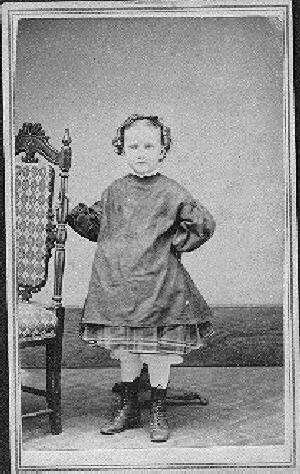
Smocks and Smock Frocks: Chronology

Figure 1.--THis portrait was an American girl named Mina Jane Boggs. The portrait was undated, but was taken about 1865. She wears a dark-colored smock over her tartan dress. This is one of the few early photograpic portraits we have of a child wearing a smock.
|
A child (both boys and girls) may also have worn them, especially in rural areas. Since they were often worn by adult males, after breeching, a rural boy might have worn one. They were not considered in the 18th century to be specifically children's clothes as specialized clothing for children did not commonly appear until the latter part of the century. A boy wearing a smock in the 18th century would be wearing essentially adult fashions. I do not have definitive information on the smock became standard children's clothes. It presumably occurred as smocks became less commonly worn by farm workers, although artists continued to wear them. This would mean that smocks became accepted children's wear after the second half of the 19th century. Perhaps the smock's association with workmen at first discouraged many status conscious parents from adopting it as children's wear. Here photograhic images are rare because children did not normally wear smocks for a photographic portrait. We have not yet built a smock chronology, but it is project that needs to be done.
The 18th Century
A child (both boys and girls) may also have worn them, especially in rural areas. Since they were often worn by adult males, after breeching, a rural boy might have worn one. They were not considered in the 18th century to be specifically children's clothes as specialized clothing for children did not commonly appear until the latter part of the century. A boy wearing a smock in the 18th century would be wearing essentially adult fashions.
The 19th Century
I do not have definitive information on the smock became standard children's clothes. I believe that the transition from work garment to child's garment occurred in the late 19th century, but our information is still incomplete. Significant differences existed from country to country. It presumably occurred as smocks became less commonly worn by farm workers and even industrial workers in some countries, although artists continued to wear them. This would mean that smocks became accepted children's wear after the second half of the 19th century. Perhaps the smock's association with workmen at first discouraged many status conscious parents from adopting it as children's wear. Here photograhic images are rare because children did not normally wear smocks for a photographic portrait. They were normally dressed up.
The 20th Century
Much more information is available for the 20th century. We note boys wearing smocjs at home and even more commonly for school in several European countries. The popularity and styles varies widely from country to country. We note a Czech boy wearing a home sock in 1925.
HBC

Navigate the Boys' Historical Clothing Smock-related pages:
[Return to the Main smock page]
[Pinafores]
[Fauntleroy suits]
[Fauntleroy dresses]
[Sailor hats]
[Park outings]
[French page]
[Renoir page]
[School smocks]
Navigate the Boys' Historical Clothing Web Site:
[Introduction]
[Activities]
[Biographies]
[Chronology]
[Clothing styles]
[Countries]
[Bibliographies]
[Contributions]
[FAQs]
[Glossaries]
[Satellite sites]
[Tools]
[Boys' Clothing Home]
Created: June 2, 2002
Last updated: 3:42 PM 6/9/2006



